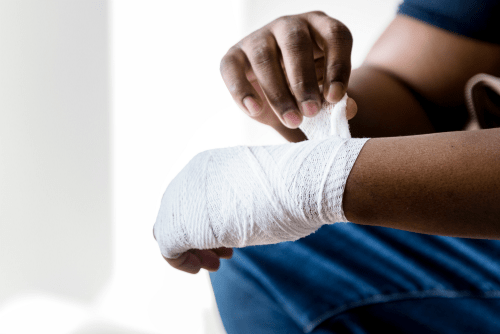1. Trips, Slips And Falls
Slips, trips and falls account for one-third of all personal injuries in the workplace, and they’re a top cause of all workers’ compensation claims. The types of injuries incurred include head, back and neck injuries, broken bones, cuts, sprains and pulled muscles.
The most common reasons for falls in the workplace are:
Slips: Occasional spills, wet or oily surfaces, weather hazards like icy steps or walkways, and loose rugs.
Trips: Poor lighting, clutter, wrinkled carpeting or mats, uncovered cables, and uneven walking surfaces.
There are 3 keys to preventing these types of workplace accidents: good housekeeping, quality walking surfaces and proper footwear. Beyond that, employees should be encouraged to report areas where clutter, obstruction, spillage or damage have occurred.
2. Being Struck By Or Caught In Moving Machinery
Accidents can happen to anyone working with heavy machinery although they are more common in factories, with farm equipment, and construction equipment. Machinery that’s not properly guarded is a safety hazard. When body parts get caught in or struck by exposed moving parts or flying objects from machines without protective guards, the results are often times disastrous. The long and horrifying list of machinery-related injuries includes crushed hands and arms, severed fingers, blindness and even worse.
The best way to prevent mechanical hazards is to remember that any machine part, function, or process that may cause injury MUST be safeguarded, and proper operator training as well as protective clothing must always be provided.
3. Vehicle-Related Accidents
Where there are vehicles of any kind, there’s the potential for accidents. These include being struck or run over by a moving vehicle, falling from a vehicle, being struck by objects falling from a vehicle and getting crushed by or stuck under an overturned vehicle.
Avoiding these types of accidents begins with assessing who’s at risk, as well as where and when these accidents most commonly occur. Only then are prevention measures more easily established. Focus on workplace design, ensuring all layout routes always segregate pedestrians and vehicles and make any obstructions clearly visible. Directions, speed limit and priority signs are also helpful.
4. Fire And Explosions
Explosions and fires in the workplace are frequently caused by risk factors such as faulty gas lines, improperly stored combustible materials, or open flames. The resulting injuries incurred include damage to the respiratory system, varying degrees of burns, and even potential disfigurement. Explosions and fires account for 3 percent of workplace injuries and have the highest casualty rate of all probable workplace accidents.
There are 4 types of injuries commonly associated with this type of accident:
Primary Blast: These occur due to the effects of pressure on body tissues, affecting ears, lungs and the GI tract.
Secondary Blast: This occurs when flying objects strike nearby workers.
Tertiary Blast: High-energy explosions can lift someone off the ground.
Quaternary Blast: Everything else that happens as a result of an explosion, such as crush injuries, burns and inhalation of toxic substances.
OSHA recommends following its hazard communication standards to help workers avoid these types of injuries. In addition, material safety data sheets for all chemicals should be kept on hand and employees should be required to wear personal protective equipment at all times.
5. Repetitive Stress and Overexertion Injuries
Musculoskeletal disorders are the most costly workplace injuries. Complaints of back pain alone cost employers more than 7 billion dollars annually and lead to more than 100 million lost workdays annually. These kinds of injuries contribute to loss of productivity and millions in annual health benefit payout costs.
The financial impact on the employer is one thing, but the long-term effects on workers can be severe and potentially debilitating and they account for nearly 33 percent of occupational injuries.
Repetitive Stress Injuries (RSIs) are the fasting growing category of workplace injury and comprise more than 100 different types of job-induced injuries, and they’re severe enough to inhibit simple activities with crippling and debilitating pain. They could even eventually permanently impair a worker’s ability to perform his or her job.
Causes for these types of injuries include:
Improper Lifting or Manually Lifting Heavy Objects: You’ve heard it a million times, lift with your knees, not your back. Especially objects weighing over 50lbs without the assistance of a co-worker or lifting device.
No Breaks: With repetitive work, short breaks should be required or the work may eventually result in wear and tear on the body.
Intensive Keying: Constant typing and clicking strains muscles and tendons.
The key to preventing these injuries is ergonomics! Ergonomics is the science of adjusting the job to fit the body’s needs and provides injury prevention solutions that are simple and relatively inexpensive. Workers assigned to tasks that require repetitive motion should be required to take frequent breaks to rest or stretch, and manual or mechanical lifting equipment should be provided for anything weighing over 50 lbs.
The best way to protect your employees and help prevent injuries in your workplace is to take a holistic approach to workplace safety. This means ensuring your employees have the proper protective equipment, adequate training to perform their jobs, and making sure your facility is compliant with federal and environmental regulations.
If you’re injured at work, immediately call Columbus Attorney Tom Marchese at 614.486.3249 or click here to get started with your free consultation.
Have a safe day!




